If your parents ever told you to eat more carrots for better vision, you’re not alone. The orange root has become synonymous with sharp eyesight. Another trendy super‑fruit, blueberries, is praised for its antioxidants and brain‑boosting powers. Which of these foods is better for your eyes? Do either actually improve your eyesight? This article explores the science behind carrots and blueberries, separates myth from fact, and offers actionable tips for eye‑healthy eating. Whether you want to reduce your risk of age‑related macular degeneration (AMD) or just take care of your vision, understanding these foods is a great place to start.
How I Finally Found Relief from Eye Strain
Then this paragraph
I used to hit 3pm with gritty, burning eyes—and a headache that wrecked my focus.
Then a coworker sent me a link I almost ignored. A few weeks later, the blurriness eased, the tension lifted, and my screen stopped “fighting” me.
Not a miracle—just a routine that finally made sense for heavy screen time.
Understanding Eye Health: Why Diet Matters
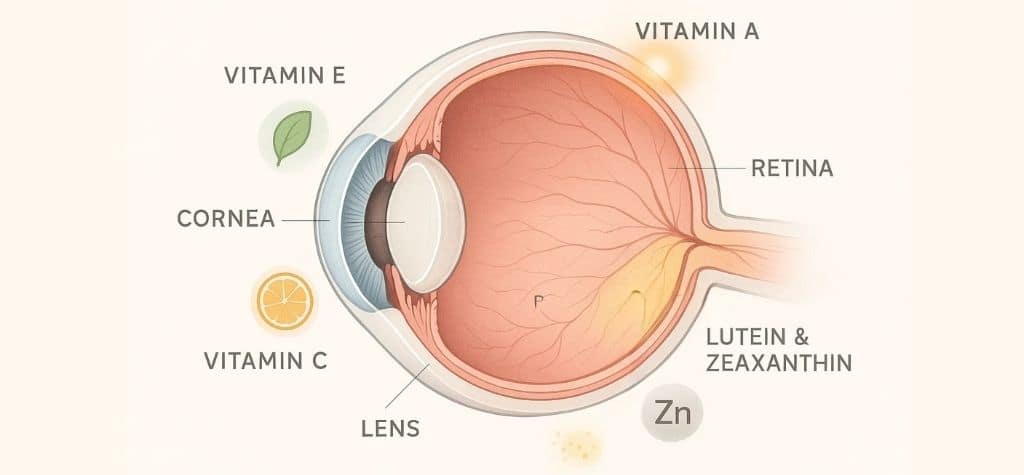
Before diving into specific foods, it helps to know how nutrients affect your eyes. The structures responsible for vision—the cornea, lens, retina, and macula—require specific vitamins and minerals. Antioxidants (vitamins A, C, E), carotenoids (beta‑carotene, lutein, zeaxanthin) and minerals like zinc play critical roles in preventing oxidative damage and supporting the normal function of photoreceptor cells in the retina. Diets rich in these nutrients can help slow the progression of diseases like AMD, cataracts and diabetic retinopathy. Conversely, poor nutrition may accelerate eye degeneration.
Why Carotenoids and Antioxidants Matter
Eye diseases often develop because light and metabolism create free radicals, molecules that damage cells. Antioxidants help neutralize these radicals. Beta‑carotene, a carotenoid in carrots, is converted to vitamin A, an essential component of rhodopsin, the light‑sensitive protein in photoreceptor cells ods.od.nih.gov. Lutein and zeaxanthin, found in leafy greens and yellow carrots, accumulate in the macula and act as a natural sunshade, filtering blue light and protecting against oxidative stress. Vitamin C helps regenerate other antioxidants, while vitamin E protects cell membranes; zinc is involved in enzyme activity and the transport of vitamin A from the liver to the retina.
Understanding these nutrients is crucial when comparing carrots and blueberries. Both foods are rich in antioxidants, but the types and amounts differ. The sections below unpack those differences.
Carrots: Beta‑Carotene and Beyond
What Makes Carrots Good for Eyes
Carrots are famous for their beta‑carotene, the orange pigment that the body converts into vitamin A. According to the U.S. National Institutes of Health (NIH), vitamin A is critical for vision because it forms rhodopsin, supports the cornea and conjunctival membranes and helps cells grow and differentiate . The NIH notes that the body converts plant‑based carotenoids (like beta‑carotene) into vitamin A in the intestine. Without enough vitamin A, people can develop night blindness or complete blindness.
A Healthline review explains that beta‑carotene rich foods like carrots are also a source of lutein—yellow carrots are particularly high in lutein—which may help prevent AMD. It emphasizes that vitamin A is fat‑soluble, so adding a healthy fat when eating carrots improves absorption.
Key takeaway: Carrots supply beta‑carotene and lutein, which your body uses to produce vitamin A and protect the macula. Vitamin A deficiency leads to night blindness, and eating carrots can help prevent this deficiency.
Debunking the World War II Carrot Myth
The idea that carrots give you exceptional night vision is deeply rooted in popular culture, yet it isn’t entirely accurate. During World War II, the British Royal Air Force developed radar to detect enemy planes. To hide this new technology, the U.K. Ministry of Information promoted the notion that pilots ate plenty of carrots to see better in the dark. Posters proclaimed that carrots would “help you see” during blackouts. This propaganda fooled many people, including the public and even some enemies, into believing that carrots bestowed catlike night vision.
A Smithsonian Magazine article clarifies that while carrots contain beta‑carotene and help prevent night blindness, they do not enhance vision beyond normal levels. John Stolarczyk, curator of the World Carrot Museum, notes that the message that carrots support eye health “became disfigured into improving eyesight”. In reality, if you’re not vitamin A deficient, eating extra carrots won’t turn you into a nocturnal superhero. The myth persists because it contains a kernel of truth: severe vitamin A deficiency leads to night blindness. But once your body has enough vitamin A, additional beta‑carotene does not sharpen your vision.
Health Benefits Beyond Vision
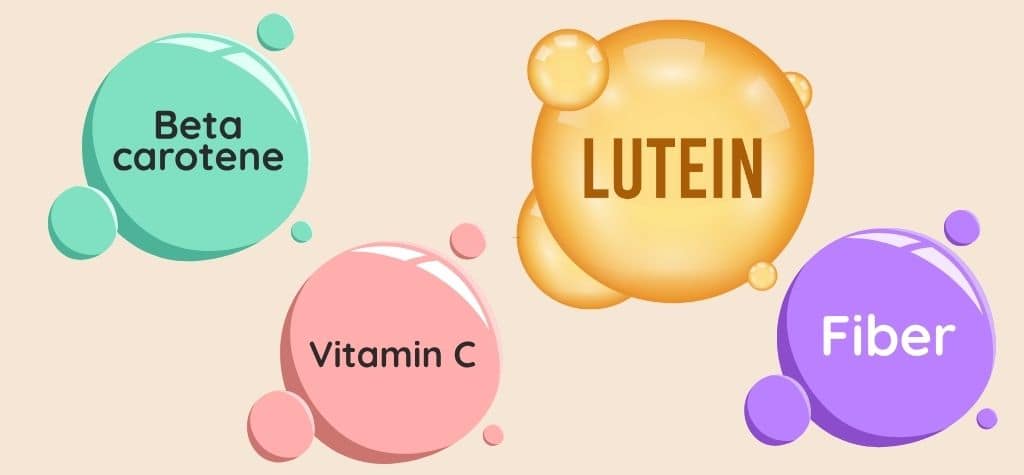
Carrots offer benefits that go beyond eye health. They’re high in fiber, supporting digestion, and contain antioxidants like lycopene and vitamin C that support heart and skin health. Their low glycemic index helps stabilize blood sugar levels, while fiber promotes satiety and may aid weight loss. Carrots also provide potassium and other micronutrients.
Nutrient highlights (per 100 g raw):
- Beta‑carotene: ~8,285 µg (converts to vitamin A)
- Lutein + zeaxanthin: ~256 µg
- Vitamin C: ~5.9 mg
- Fiber: ~2.8 g
Blueberries: Anthocyanins and Eye Health
What Are Anthocyanins?
Blueberries are lauded for their anthocyanins—water‑soluble pigments responsible for the berry’s deep blue color. These compounds belong to the flavonoid family and have strong antioxidant properties. Research shows that anthocyanins accumulate in tissues of the eye in animal studies; pigs fed blueberries had anthocyanins detected in the whole eye. This suggests that dietary anthocyanins can reach ocular tissues and potentially influence eye health.
However, evidence of anthocyanins’ benefits in humans is mixed. The National Institutes of Health review on blueberry benefits notes there are few observational studies linking anthocyanin intake to ocular disease. One Finnish study found that higher flavonoid intake correlated with reduced cataract risk; another prospective study of women found an association between blueberry intake and reduced total AMD but no association with cataract. Clinical trials provide modest support: anthocyanin supplements improved visual field defects and ocular blood flow in glaucoma patients and contrast sensitivity in diabetic retinopathy, but other studies found no improvements in dark adaptation or visual acuity.
Evidence from Clinical Trials
A randomized controlled trial published in the Journal of Agricultural and Food Chemistry tested whether blueberry anthocyanins improve dark adaptation. Two placebo‑controlled crossover studies (trials S2 and L1) examined different doses of anthocyanins (271–346 mg cyanidin‑3‑glucoside equivalents). The results showed neither dark adaptation nor night vision improved with anthocyanin intake. However, the consumption of anthocyanins hastened recovery of visual acuity after photobleaching, meaning participants recovered more quickly from temporary glare when their retinas had been exposed to bright light. Whether this improvement translates to daily life is unknown.
Long‑Term Population Studies
In 2024, researchers from Brigham and Women’s Hospital published findings from the Women’s Health Study, which followed over 37,000 women for more than two decades. They investigated the relationship between blueberry intake and age‑related eye diseases. The results: women consuming more than one serving of blueberries per week had a 28% reduction in the risk of total AMD, though there was no reduction in visually significant AMD. Moreover, the researchers did not find an association between increasing anthocyanin intake and AMD, but they did observe a modest inverse association with cataracts. In other words, blueberries may offer some protection against early AMD and cataracts but are not a cure‑all.
General Health Benefits of Blueberries
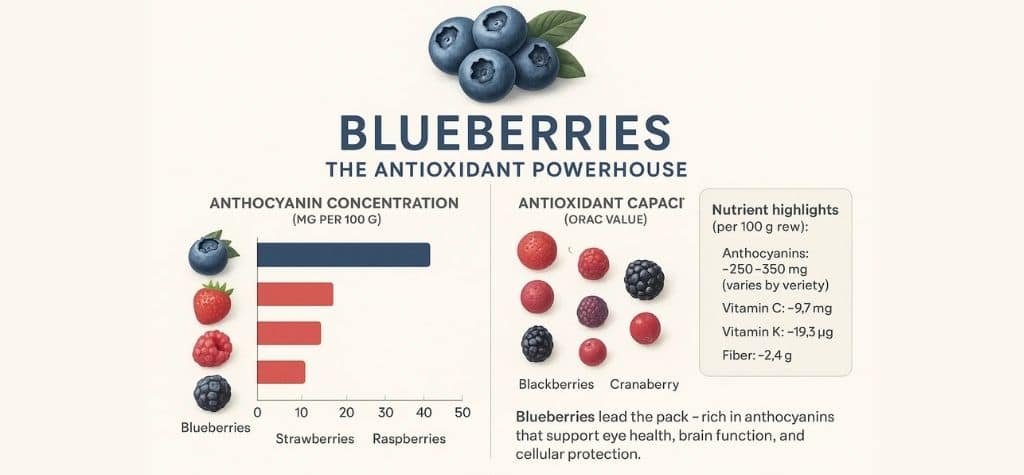
Even if blueberry research for eye health is inconsistent, these berries remain a nutritional powerhouse. The Cleveland Clinic notes that blueberries are rich in antioxidants, especially anthocyanins, with a cup of cultivated blueberries delivering over 9,000 total antioxidants. They are also high in vitamin C, vitamin K, manganese, and soluble fiber. These nutrients support immune function, blood clotting, cholesterol management and gut health, respectively. Blueberries may help lower blood pressure and improve heart health.
Nutrient highlights (per 100 g raw):
- Anthocyanins: ~250–350 mg (varies by variety)
- Vitamin C: ~9.7 mg
- Vitamin K: ~19.3 µg
- Fiber: ~2.4 g
Comparing Carrots and Blueberries for Eye Health
Nutrient Differences
| Nutrient | Carrots (per 100 g) | Blueberries (per 100 g) | Notes |
|---|---|---|---|
| Beta‑carotene / Vitamin A precursor | ~8,285 µg | Negligible | Carrots provide vitamin A precursors; blueberries do not. |
| Lutein + zeaxanthin | ~256 µg | Trace | Carrots, especially yellow ones, contain lutein and zeaxanthin |
| Vitamin C | 5.9 mg | 9.7 mg | Blueberries offer more vitamin C. |
| Anthocyanins | Trace | 250–350 mg | Only blueberries provide significant anthocyanins. |
| Fiber | 2.8 g | 2.4 g | Both are good sources of fiber. |
| Calories | ~41 kcal | ~57 kcal | Both are low‑calorie foods. |
This comparison shows that carrots excel at providing beta‑carotene and lutein, while blueberries excel at anthocyanins and vitamin C. Both contribute fiber and other micronutrients. Because they supply different antioxidants, neither is strictly superior; they are complementary foods.
Which Food Improves Eyesight?
From the scientific evidence, carrots help prevent night blindness by supplying vitamin A precursors. If you are vitamin A deficient—common in low‑income settings—eating carrots can restore normal night vision. However, for people with adequate vitamin A intake, extra carrots don’t sharpen vision.
Blueberries, meanwhile, deliver anthocyanins that may help protect retinal tissues and speed recovery from glare. The Women’s Health Study found modest benefits for early AMD but none for advanced AMD. Clinical trials show no improvement in dark adaptation. Thus, blueberries may support long‑term eye health but won’t dramatically improve acuity or night vision.
Bottom line: Neither carrots nor blueberries will turn you into a superhero with x‑ray vision. Carrots prevent deficiency‑related night blindness, and blueberries provide antioxidants that may reduce the risk of degenerative diseases. Including both foods in a balanced diet is the wisest approach.
The Role of Other Foods and Nutrients
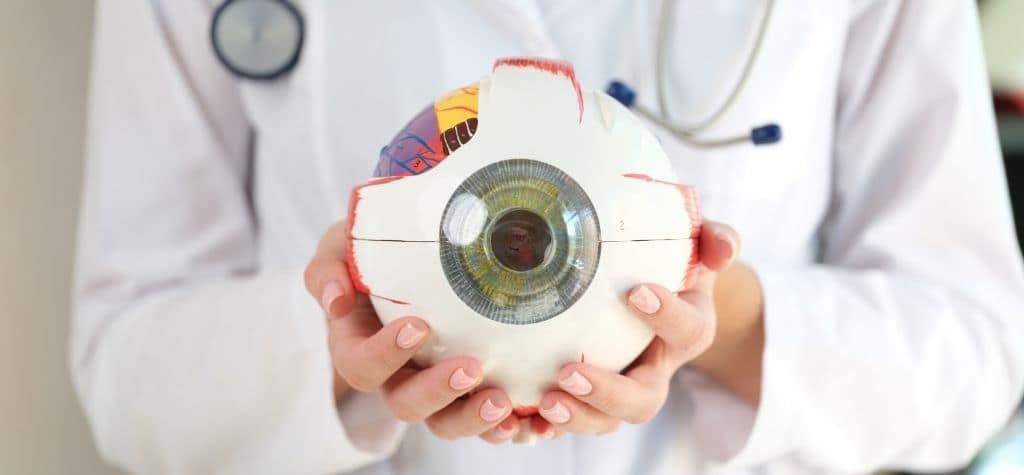
AREDS and AREDS2: Evidence for Supplements
The National Eye Institute (NEI) conducted landmark randomized trials—the Age‑Related Eye Disease Study (AREDS) and its follow‑up, AREDS2—to assess whether specific supplements slow AMD progression. Participants at high risk for advanced AMD took high doses of vitamin C, vitamin E, beta‑carotene, zinc and copper. Results showed that these nutrients reduced the risk of progressing to advanced AMD by about 25% and cut the risk of vision loss by 19%. However, they did not prevent cataracts. The NEI emphasized that these supplements are not a cure and cannot restore lost vision, but they help slow disease progression.
In AREDS2, researchers replaced beta‑carotene with lutein and zeaxanthin because beta‑carotene was associated with lung cancer risk in smokers. The modified formulation still slowed AMD progression, and lutein/zeaxanthin were safer. Adding omega‑3 fatty acids did not yield additional benefits. These studies highlight that a combination of antioxidants and zinc is more effective for AMD than any single nutrient.
Foods Recommended for Eye Health
Beyond carrots and blueberries, many fruits and vegetables supply the antioxidants your eyes need. The Mayo Clinic, citing the NEI, lists kale, collard greens, peppers, broccoli, sweet potato, spinach, peas, pumpkin, carrots and Swiss chard as top vegetables for eye health. For fruits, they recommend peaches, blueberries, oranges, tangerines, mangoes, tomatoes, apricots, papaya, cantaloupe, honeydew and avocados. Zinc‑rich foods like crab, lean beef, fortified cereals and pumpkin seeds support zinc levels, while omega‑3 fatty acids from salmon, tuna, flaxseed and walnuts benefit the retina.
Creating a Balanced Vision‑Friendly Diet
No single food will ensure perfect eyesight. A diverse diet emphasizing colorful fruits and vegetables, whole grains, lean proteins and healthy fats provides a spectrum of nutrients. Consider:
- Leafy greens (spinach, kale, collard greens) for lutein and zeaxanthin.
- Orange/yellow vegetables (carrots, sweet potatoes, squash) for beta‑carotene and vitamin A.
- Berries and purple fruits (blueberries, blackberries, purple grapes) for anthocyanins.
- Citrus fruits (oranges, tangerines, grapefruits) for vitamin C.
- Nuts and seeds (almonds, sunflower seeds, pumpkin seeds) for vitamin E and zinc.
- Oily fish (salmon, mackerel, sardines) and plant sources (flaxseed, chia seeds) for omega‑3 fatty acids.
Tip: When eating beta‑carotene–rich foods like carrots or sweet potatoes, include a small amount of healthy fat (e.g., olive oil or avocado) to enhance.
How to Incorporate Carrots and Blueberries into Your Diet
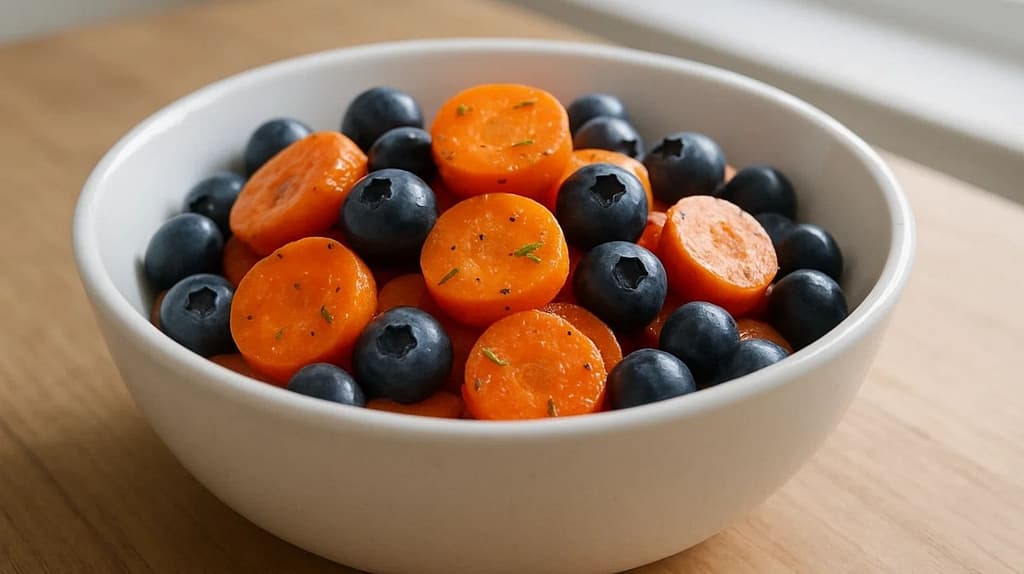
Simple Ways to Enjoy Carrots
- Raw snacks: Slice carrots into sticks and pair with hummus or yogurt dip.
- Roasted: Toss carrot chunks with olive oil and herbs, then roast until tender. Roasting enhances beta‑carotene absorption because heat breaks down cell walls.
- Soups and stews: Add diced carrots to soups, stews or curries for flavor and nutrients.
- Smoothies: Blend carrots with orange juice, ginger, and a banana for a vibrant smoothie. Add flaxseed for omega‑3s.
Creative Blueberry Dishes
- Fresh topping: Sprinkle blueberries on oatmeal, cereal, yogurt or salads.
- Smoothies: Blend blueberries with spinach, frozen banana and almond milk. The spinach provides additional lutein.
- Trail mix: Mix dried blueberries with nuts and seeds for a portable snack.
- Sauces: Make a blueberry compote to top whole‑grain pancakes or mix into plain yogurt.
Including both foods regularly ensures you get the complementary benefits of beta‑carotene, lutein and anthocyanins.
Myths and Misconceptions About Vision
Myth 1: “Eating carrots improves your vision beyond normal.”
Truth: Carrots prevent night blindness caused by vitamin A deficiency. They do not sharpen vision in people with adequate vitamin A. The World War II propaganda linking carrots to pilot night vision was designed to hide radar technology.
Myth 2: “Blueberries can dramatically improve night vision.”
Truth: Clinical trials found no improvement in dark adaptation or night vision after consuming blueberry anthocyanins. They may speed glare recovery but won’t help you see in the dark. Observational studies show that moderate blueberry consumption may reduce AMD risk.
Myth 3: “Eating one superfood is enough to keep your eyes healthy.”
Truth: Eye health depends on a diverse diet and lifestyle factors. Smoking, excessive screen time, and unprotected sun exposure can harm your eyes. Nutrients work synergistically; for example, the AREDS studies used combinations of vitamins C, E, beta‑carotene, zinc, copper, and later lutein and zeaxanthin. A single food cannot provide all these.
Myth 4: “If you don’t wear your glasses, your eyes will get stronger.”
Truth: Not wearing corrective lenses can strain your eyes and cause headaches but won’t improve vision. Always follow your optometrist’s advice.
Eye Health Tips Beyond Diet

While diet plays a major role, other habits are essential for preserving vision:
- Get regular eye exams: Early detection of glaucoma, AMD and diabetic retinopathy improves outcomes. Adults should see an eye professional at least every 1–2 years.
- Protect your eyes from UV light: Wear sunglasses that block 99–100% of UVA and UVB rays.
- Rest your eyes: Use the 20‑20‑20 rule: every 20 minutes, look 20 feet away for 20 seconds to reduce digital eyestrain.
- Maintain overall health: Control blood pressure, manage diabetes and avoid smoking. These factors influence eye disease risk.
- Stay active: Physical activity supports vascular health and reduces inflammation, which benefits the eyes.
Conclusion: The Science Says Eat Both
Carrots and blueberries offer unique nutrients that contribute to eye health. Carrots are an excellent source of beta‑carotene and lutein; they prevent night blindness and support the cornea and retina. However, they do not enhance vision beyond correcting vitamin A deficiency or treating refractive errors. Blueberries provide anthocyanins and vitamin C, which deliver strong antioxidant effects. These compounds may modestly reduce the risk of AMD and help eyes recover from glare, though studies do not show improvements in night vision.
The best strategy is to include both foods—along with leafy greens, citrus fruits, nuts, seeds and omega‑3–rich fish—in a balanced diet. Such diversity ensures you get the full spectrum of vitamins, minerals and phytonutrients your eyes need. When paired with regular eye exams, sun protection, and healthy lifestyle habits, your diet becomes a powerful tool for maintaining lifelong vision.
By integrating a variety of nutrient‑dense foods and healthy habits, you can nourish your eyes and protect your vision well into the future. Balanced eating matters more than choosing a single “magic” food—so enjoy your carrots and blueberries along with a rainbow of other fruits and vegetables.

